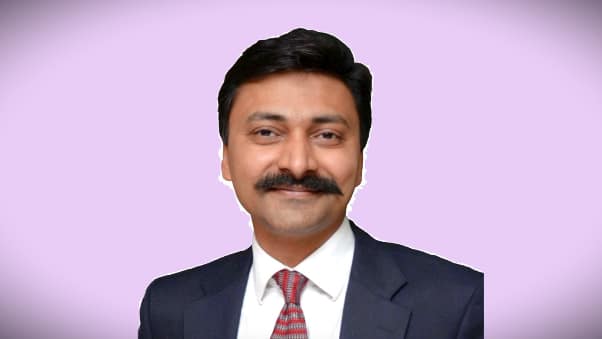Anand Agarwal, CFO of V-Mart Retail, blends a digital-first approach from founding three tech startups with deep finance expertise. A lifelong learner, he’s studying advanced Python and explores diverse interests, from anthropology and history to technology, often sparked by podcasts.

Anand Agarwal, CFO, V-Mart Retail
A finance leader in profession and a coder and techie at heart, Anand Agarwal, CFO of V-Mart Retail, in conversation with FE CFO discusses his mindset behind strategies when it comes to long term focus on growth or making decisions in a world of enormous data.
V-Mart Retail focuses on long-term, sustainable institutions rather than chasing short-term growth. With organised retail comprising 30% to 35% of the Indian market, and the industry growing at 10% to 15% annually, the CFO sees immense headroom to grow, especially in the apparel segment, driven by rising aspirations across lower-income households earning Rs 20,000 to Rs 50,000 per month.
V-Mart focuses on sustainable growth, ensuring each new store is performance-ready from day one.
“We’re not rushing to open 100 stores in a month. Instead, we deliberately seek that every store we open must be sustainable, with strong performance from day 1,” says? Edited excerpts.
Q: Congratulations on reaching the 500-store mark this year. What kind of capital expenditure are you planning next?
Yes, we recently crossed the 500-store milestone. For FY26, we have planned a capex of around Rs 120 crores. We aim to add about 65 new stores this year. Our goal is to grow our retail area by around 12% to 15% annually.
Over the last 22 years, nearly 90% of our stores have become profitable at the store level within the first month of launch. That’s something we’re proud of. With a horizon of 5 to 10 years, the emphasis is on strengthening core capabilities, aligning store offerings with local demand, and executing consistently. This strategy, rooted in discipline and scalability, is key to reinforcing financial fundamentals and sustaining investor confidence.
Q: You operate primarily in Tier 2 to Tier 4 cities. Where do you see the maximum growth coming from over the next 2–3 years?
Today, India’s urbanisation story is also about the rise of regional power centers like Lucknow, Jaipur, Banaras, and Gorakhpur. Earlier known only for their religious or administrative significance, these cities are now hubs of investment, infrastructure, and consumer demand. As rural migration fuels rising aspirations, V-Mart steps in to serve the value-conscious customer who seeks quality retail experiences without premium price tags.
Our focus is firmly on Tier 2, 3, and 4 markets, not just by geography, but by consumer mindset. Even in Tier 1 cities, we’re present in neighborhoods like Burari Village in Delhi, not Connaught Place, because that’s where our customers live. Our cluster-based expansion strategy ensures operational efficiency by building density around each new store. Today, we operate across every Indian state, except Goa, which we exited strategically a few years ago.
Q: Retail is often exposed to demand shocks, seasonality, and inventory risk. How do you model risk in your growth strategy?
Risk and business go hand in hand. If there’s no risk, you’re likely selling a commodity that won’t generate enough returns to sustain scale. The biggest risk in retail is inventory. So we’ve built multiple guardrails:
Tech-driven inventory systems to forecast and optimize ordering cycles
Synchronized collaboration between purchase, supply chain, and operations teams
Transparent communication and data-sharing across functions
Hard system limits and controls with room for strategic decision-making when needed
But the most important risk mitigator is strong governance. If your processes, controls, and internal transparency are solid, you’ll self-regulate against taking undue risks.
Q: How much of your decision-making today is driven by data and tech?
About 70–80% of our decisions are data-driven. We analyse every store and every geography continuously. We correlate trends, check real-time results, and adjust. The agility of digital tools allows faster, smarter decisions, especially compared to gut-based decisions of the past.
Q: And yet—do you still rely on gut instinct?
Yes, of course. When the data is close, and the call is subjective, gut plays a role. Experience fills the gaps that data can’t. Tech can tell you what’s happened, but it may miss the unwritten context, the human variables, the emotion behind a trend, or operational nuance.
Q: How are you staying ahead personally and professionally?
If you stop learning, you stop living.
I’ve always had a digital mindset. I ran three tech startups before entering finance. I’m still actively learning; I have attended three workshops on AI, I'm pursuing advanced Python, and doing a year-long leadership and strategy program. I read, I attend conferences, I listen to daily podcasts, not just on finance but on anthropology, strategy, and technology.
You can’t wait for disruption, you have to be ready before it hits.
Q: What are your top priorities for the next two financial years?
There are three key focus areas:
Digital evolution: It's not enough for the leadership to attend workshops. The entire team must adopt and internalise digital tools to make their work easier and smarter. My goal is to lead that shift, making the organisation more digitally attuned so we can leverage emerging technologies effectively.
Agile risk management: Earlier, we would review our risk register every quarter. Now, we are forced to do it almost every week. The global environment is so volatile whether it’s geopolitical conflicts like the Iran-Israel war, oil price shocks, or tariff changes all of it has ripple effects. Even if we don’t directly import, our upstream suppliers might, and that impacts us indirectly.
Navigating regulatory flux: There’s an increasing volume of data and compliance requirements. While this will ultimately strengthen the corporate ecosystem, in the short run, companies need to build internal capability to handle this heightened scrutiny and reporting load.
Q: What defines strong leadership in the retail industry today, especially from a strategic financial lens at a value-driven company like V-Mart?
Strong leadership is about creating trust, demonstrating empathy, and managing change effectively. In value retail, strategic financial leadership plays a critical role. Many confuse “value” with “cheap,” but true value is far more nuanced—and deeply ethical.
You cannot deliver value to customers by unfairly squeezing your vendors. Ethical sourcing and operational efficiency must go hand in hand.
Financial strategy, therefore, is about optimising cost structures, supply chains, and sourcing practices without compromising integrity. At V-Mart, nearly 70% of our sales come from repeat customers—a reflection of our commitment to offering consistent quality at a fair price. That kind of loyalty is built on trust, not just transactions.
By continuing you agree to our Privacy Policy & Terms & Conditions
